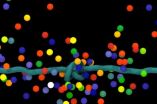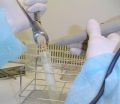(Press-News.org) A new home-grown instrument based on bundles of optical fibres is giving Australian astronomers the first 'Google street view' of the cosmos — incredibly detailed views of huge numbers of galaxies.
Developed by researchers at the University of Sydney and the Australian Astronomical Observatory, the optical-fibre bundles can sample the light from up to 60 parts of a galaxy, for a dozen galaxies at a time.
By analysing the light's spectrum astronomers can learn how gas and stars move within each galaxy, where the young stars are forming and where the old stars live. This will allow them to better understand how galaxies change over time and what drives that change.
"It's a giant step," said Dr James Allen of the ARC Centre of Excellence for All-sky Astrophysics(CAASTRO) at the University of Sydney.
"Before, we could study one galaxy at a time in detail, or lots of galaxies at once but in much less detail. Now we have both the numbers and the detail."
The Australian team is now a year or two ahead of its international competition in this field. In just 64 nights it has gathered data on 1000 galaxies, twice as many as the previous largest project, and over the next two years it will study another 2000.
CAASTRO funding was crucial in helping the team gain its lead. "They had a great idea but it was going to take time to pull the resources together," said the organisation's director Professor Bryan Gaensler. "CAASTRO was able to get it happening fast."
Called SAMI (the Sydney-AAO Multi-Object Integral field spectrograph), the optical-fibre instrument was installed on the 4-m Anglo-Australian Telescope at Siding Spring Observatory in northwest NSW last year.
The technological leap is the 'hexabundle', sixty or more optical fibres close-packed and fused together, developed by the University of Sydney's astrophotonics group led by Professor Joss Bland-Hawthorn.
Using the new instrument astronomers from the Australian National University and the University of Sydney have already spotted 'galactic winds'—streams of charged particles travelling at up to 3,000 km a second—from the centre of two galaxies.
"We've seen galactic winds in other galaxies, but we have no idea how common they really are, because we've never had the means to look for them systematically. Now we do," said the University of Sydney's Associate Professor Scott Croom, a Chief Investigator on the project.
The researchers are also uncovering the formation history of galaxies by looking to see if they are rotating in a regular way or if the movement of their stars is random and disordered.
"There are hints that galaxies with random motions sit at the centres of groups of galaxies, where many smaller galaxies may have fallen into them," said Dr Lisa Fogarty, a CAASTRO researcher at the University of Sydney who led this work.
On Thursday 24 July the researchers will release the first set of data from the instrument to the worldwide astronomical community and Dr Allen will give a related presentation at the annual scientific meetingof the Astronomical Society of Australia.
INFORMATION:
Australian researchers pioneer a 'Google street view' of galaxies
2014-07-23
ELSE PRESS RELEASES FROM THIS DATE:
K computer runs largest ever ensemble simulation of global weather
2014-07-23
Ensemble forecasting is a key part of weather forecasting today. Computers typically run multiple simulations, called ensembles, using slightly different initial conditions or assumptions, and then analyze them together to try to improve forecasts. Now, using Japan's flagship 10-petaFLOPS K computer, researchers from the RIKEN Advanced Institute for Computational Science (AICS) have succeeded in running 10,240 parallel simulations of global weather, the largest number ever performed, using data assimilation to reduce the range of uncertainties.
The assimilation of the ...
Physical work environment in hospitals affects nurses' job satisfaction
2014-07-23
Job satisfaction is an important predictor of registered nurses' (RNs) job turnover, patient satisfaction, and nurse-sensitive patient outcomes (including pressure ulcers and falls), which can result in higher health care costs and penalties for hospitals that receive Medicare and Medicaid payments. Numerous studies have been conducted to assess nurses' job satisfaction, asking about nurse-physician relationships, opportunities for promotion, autonomy, and similar issues, but very few have addressed the impact of the physical work environment on RNs' job satisfaction.
Now, ...
Minimizing drag to maximize results
2014-07-23
One of the most exciting parts of the Tour de France for spectators is the tactical vying for spots in the breakaway group at the front of the pack.
In trying to better understand the aerodynamic interactions between cyclists, researchers from Monash University and the Australian Institute of Sport studied how riders' drag was affected by the relative position of multiple cyclists (in a formation).
Nathan Barry, a PhD student from the Department of Mechanical and Aerospace Engineering, said the research, undertaken by the Monash Wind Tunnel Sports Group, was designed ...
MIPT-based researcher models Titan's atmosphere
2014-07-23
A researcher from Moscow Institute of Physics and Technology, Prof. Vladimir Krasnopolsky, who heads the Laboratory of High Resolution Infrared Spectroscopy of Planetary Atmospheres, has published the results of the comparison of his model of Titan's atmosphere with the latest data.
The article in the journal Icarus compares the chemical composition of Titan's atmosphere with parameters predicted by a mathematical model. The atmosphere of Saturn's largest moon was described by a model that took into account the presence of 83 neutral molecules and33 ions and420 different ...
Vanderbilt-led study identifies genes linked to breast cancer in East Asian women
2014-07-23
A new study in East Asian women has identified three genetic changes linked to an increased risk of breast cancer. The research, led by Vanderbilt University investigators, was published online July 20 in Nature Genetics.
While breast cancer is one of the most common malignancies among women worldwide, most studies of the genetic risk factors for the disease have focused on women of European ancestry.
Given the differences in genetic heritage and environmental exposures between East Asian women and those of European ancestry, the investigators decided to conduct a study ...
Scientists find way to maintain quantum entanglement in amplified signals
2014-07-23
Physicists Sergei Filippov (MIPT and Russian Quantum Center at Skolkovo) and Mario Ziman (Masaryk University in Brno, Czech Republic, and the Institute of Physics in Bratislava, Slovakia) have found a way to preserve quantum entanglement of particles passing through an amplifier and, conversely, when transmitting a signal over long distances. Details are provided in an article published in the journal Physical Review A (see preprint).
Quantum entangled particles are considered to be the basis of several promising technologies, including quantum computers and communication ...
Obesity linked to low endurance, increased fatigue in the workplace
2014-07-23
FALLS CHURCH, Va. -- U.S. workplaces may need to consider innovative methods to prevent fatigue from developing in employees who are obese. Based on results from a new study published in the Journal of Occupational and Environmental Hygiene (JOEH), workers who are obese may have significantly shorter endurance times when performing workplace tasks, compared with their non-obese counterparts.
The study, conducted at Virginia Tech in Blacksburg, Va., examined the endurance of 32 individuals in four categories (non-obese young, obese young, non-obese older, and obese older) ...
The electric slide dance of DNA knots
2014-07-23
DNA has the nasty habit of getting tangled and forming knots. Scientists study these knots to understand their function and learn how to disentangle them (e.g. useful for gene sequencing techniques). Cristian Micheletti, professor at the International School for Advanced Studies (SISSA) in Trieste and his team have been carrying out research in which they simulate these knots and their dynamics. In their latest paper, just published in the journal Soft Matter, Micheletti together with Marco Di Stefano, first author and PhD student at SISSA, and colleagues from Ljubljana ...
Ancient genetic material from caries bacterium obtained for the first time
2014-07-23
Streptococcus mutans, one of the principal bacteria that cause dental caries, has increased the change in its genetic material over time, possibly coinciding with dietary change linked to the expansion of humanity. This is highlighted in a study by researchers from the Universitat Autònoma de Barcelona (UAB) and the Laboratorio Nacional de Genómica para la Biodiversidad (National Laboratory of Genomics for Biodiversity) in Mexico who, for the first time, have sequenced genetic material from this bacterium in populations from the past. Increase in genetic diversity has ...
Linking television and the Internet
2014-07-23
The panel discussion is getting heated -- but what exactly is in the new proposed law that the experts on TV are arguing about so vigorously? Up until now, spontaneous questions such as these that arise during a program had to be clarified through a viewer's own research on the Internet.
If it's up to researchers at the Fraunhofer Institute for Intelligent Analysis and Information Systems IAIS in Sankt Augustin, Germany, viewers will no longer have to look up such additional information in the future. In the project "LinkedTV", the institute is working with eleven partners ...




